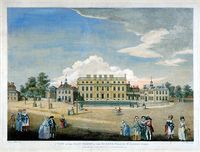Annotation:Queen's Palace: Difference between revisions
(Created page with "=='''Back to [[{{BASEPAGENAME}}]]'''== ---- <p><font face="garamond, serif" size="4"> '''QUEEN'S PALACE.''' English, Country Dance Tune (2/4 time). G Major. Standard tuning (f...") |
m (Text replacement - "garamond, serif" to "sans-serif") |
||
| (One intermediate revision by one other user not shown) | |||
| Line 1: | Line 1: | ||
=='''Back to [[{{BASEPAGENAME}}]]'''== | =='''Back to [[{{BASEPAGENAME}}]]'''== | ||
---- | ---- | ||
<p><font face=" | <p><font face="sans-serif" size="4"> | ||
'''QUEEN'S PALACE.''' English, Country Dance Tune (2/4 time). G Major. Standard tuning (fiddle). AABB. The melody also appears in London publisher Thomas Skillern's '''Skillern's Compleat Collection of Two Hundred & Four Reels''' (1780). | '''QUEEN'S PALACE.''' English, Country Dance Tune (2/4 time). G Major. Standard tuning (fiddle). AABB. The melody also appears in London publisher Thomas Skillern's '''Skillern's Compleat Collection of Two Hundred & Four Reels''' (1780). | ||
<BR> | |||
<br> | |||
[[File:queenspalace.jpg|200px|thumb|left|The Queen's Palace, St. James's Park]] The Queen's Palace began as Arlington House, then, rebuilt from the ground in 1703, as Buckingham House. Early in the reign of George III he purchased the property as a royal residence, thinking it would house his growing family, and it became known as the Queen's Palace. However, both he and Queen Charlotte preferred residences at Kew and Windsor. The structure was enlarged during the Regency of Prince George (later George IV) and became Buckingham Palace. | |||
<br> | <br> | ||
<br> | <br> | ||
</font></p> | </font></p> | ||
<p><font face=" | <p><font face="sans-serif" size="4"> | ||
''Source for notated version'': | ''Source for notated version'': | ||
<br> | <br> | ||
<br> | <br> | ||
</font></p> | </font></p> | ||
<p><font face=" | <p><font face="sans-serif" size="4"> | ||
''Printed sources'': Straight and Skillern ('''Two Hundred and Four Favourite Country Dances, vol. 1'''), c. 1775; No. 18, p. 9. | ''Printed sources'': Straight and Skillern ('''Two Hundred and Four Favourite Country Dances, vol. 1'''), c. 1775; No. 18, p. 9. | ||
<br> | <br> | ||
<br> | <br> | ||
</font></p> | </font></p> | ||
<p><font face=" | <p><font face="sans-serif" size="4"> | ||
''Recorded sources'': <font color=teal></font> | ''Recorded sources'': <font color=teal></font> | ||
</font></p> | </font></p> | ||
Latest revision as of 14:36, 6 May 2019
Back to Queen's Palace
QUEEN'S PALACE. English, Country Dance Tune (2/4 time). G Major. Standard tuning (fiddle). AABB. The melody also appears in London publisher Thomas Skillern's Skillern's Compleat Collection of Two Hundred & Four Reels (1780).

The Queen's Palace began as Arlington House, then, rebuilt from the ground in 1703, as Buckingham House. Early in the reign of George III he purchased the property as a royal residence, thinking it would house his growing family, and it became known as the Queen's Palace. However, both he and Queen Charlotte preferred residences at Kew and Windsor. The structure was enlarged during the Regency of Prince George (later George IV) and became Buckingham Palace.
Source for notated version:
Printed sources: Straight and Skillern (Two Hundred and Four Favourite Country Dances, vol. 1), c. 1775; No. 18, p. 9.
Recorded sources:
